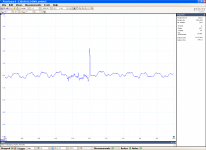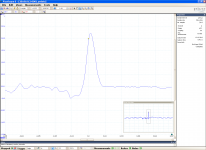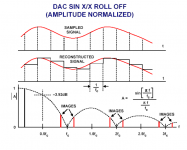I can't speak for 'people', but for me, if I had that sort of disposable income and didn't DIY as much as possible I would certainly be tempted. Some react in horror about digitising an analog source. I am not one of them and Scott's work has put a lot of the boogymen of digital RIAA to rest.
Just read some of the channel D reviews. The tech is really good now.
Just read some of the channel D reviews. The tech is really good now.
There's decent equipment, but honestly a good DAC is far from cheap. Even if the sound is good, it's just extra stuff; and despite the fact it's definitely ethically questionable even from one's own perspective. Ya I know a bunch of nerds are going to say, "if it sounds good it sounds good" but for example if I wanted to get a milkshake at a classic diner, and you took me to Sonic and I got just as of an authentic milkshake I'd still be disappointed. The experience isn't just the end result for everyone.
All the measurements I have seen recently suggest a good DAC is exceedingly affordable. You have your own particular set of irrational preferences. That's fine. I don't have to listen to your system nor you mine.
Do your LPs have a note to say if 'all analogue' or used a digital delay line in mastering?
In UK Sonic is a hedgehog and kids drink milkshake so I am afraid you analogy means nothing to me...
Do your LPs have a note to say if 'all analogue' or used a digital delay line in mastering?
In UK Sonic is a hedgehog and kids drink milkshake so I am afraid you analogy means nothing to me...
... and the dots are the actual sample values?
Jan
Yes the line is a sinc interpolated visual.
All the measurements I have seen recently suggest a good DAC is exceedingly affordable. You have your own particular set of irrational preferences. That's fine. I don't have to listen to your system nor you mine.
Do your LPs have a note to say if 'all analogue' or used a digital delay line in mastering?
In UK Sonic is a hedgehog and kids drink milkshake so I am afraid you analogy means nothing to me...
You're just being argumentative Bill. It's a subjective hobby so the only irrational is telling someone to do something they don't want and then telling them to enjoy it because it's rational. When your wife says, "come with me to this play" and when you say you're not too interested and she says, "I don't want to go by myself, come with me." At that point do you suggest she go with John or Susan, because she won't be by herself? You know plenty well that for some people going with a friend might be fine but just as likely (maybe more) they want to go with you even though there's no "rational" reason you have to be there for her to enjoy it, or that it must be you in order for her requirements to be fulfilled. The rational can be she wants to go with you. Just like when someone wants to listen to analog, they may seriously mean they want to listen to analog so the rational is that an ADC to DAC isn't in the bag.
Furthermore you know as well as I do when you cut/press in the vinyl process you're doing a physical conversion to analog, and from equipment beyond mere mortals. And personally I've found some of the better analog-from-the-start albums to sound better than even really nice digital origin albums. However it's not that important since I enjoy the medium.
BTW DAC's have measured well forever, doesn't mean they've all sounded good. The Oppo sounds bad, and my cd player has about the same specs, for example (even the highly modified ModWright one isn't good).
Scott,
11 Myths About Analog Noise Analysis | Analog content from Electronic Design
In the second item I am just not seeing how he gets his noise numbers. Any light would be appreciated.
I.E. 300e-9 x sqrt(50,000) x K = 9.7e-6 sort of (K=1.45!)
39e-9 x sqrt(1000) x Ke-3 = 8.7e-6 ??
4e-9 x sqrt(3e6) x K = 8.7e-6 (K=1.16!)
K is rolloff vs brickwall correction.
ES
Thanks Ed, this is a mess I'm afraid.
Me being argumentative? We have a new Mr.Pot!
Come on how many albums do you have that have not gone through a digital delay line during mastering? 5% maybe? For me if some DSP enhances the experience by removing extraneous ticks and pops that is a good thing. My opinion. Not an argument, just stating an opinion.
My wife and I enjoy concerts, Ballet and theatre. we go because we want to go together. You clearly have a less harmonious experience. Please however keep my wife out of the discussion.
Come on how many albums do you have that have not gone through a digital delay line during mastering? 5% maybe? For me if some DSP enhances the experience by removing extraneous ticks and pops that is a good thing. My opinion. Not an argument, just stating an opinion.
My wife and I enjoy concerts, Ballet and theatre. we go because we want to go together. You clearly have a less harmonious experience. Please however keep my wife out of the discussion.
What's the time scale on that x axis?
Stuart, time axis is 1ms/ screen division in Scott’s screenshot.
Yes Jan. The line connects the dots for an analog ‘looks’ (In addition to that, horizontal axis can show either time or samples number).... and the dots are the actual sample values?
I was looking at some of my vinyl rips and I found a waveform very similar to Scott’s, see attachment 1. You will see the analog-like representation from “Cool Edit” and the actual staircase form from “Wavelab”
Recording was made at the RIAA pre output 0dB=1.286Vrms
Hi EdI practice there is about 30 dB of attenuation re 1,000 hertz for the scratches, the last time I looked at that almost 40 years ago.
From the exponential recovery seen on attachment 1, I deduced the low pass filter time constant.
It is 170ns implying a cut-off freq of around 1kHz. Tomorrow I will try to make some flat recordings from this vinyl record for to compare the waveforms.
In the digital signal processing, the give away of the signal that is caused by dirt or a scratch is the fall time. Musical notes decay, impulse noise falls off without decay.
Impulse noise experiences decay as well, due to cartridge mechanical/magnetic LP filtering and the LP filtering from the interface and any filtering in the preamplifier.
Musical instrument notes have their own longer acoustic time delay added.
So, attack and release profile, phase relation and amplitude, all these are the give away for dirt/scratch/static discharge signals. (see attachments 2 to 7) 🙂
George
Attachments
-
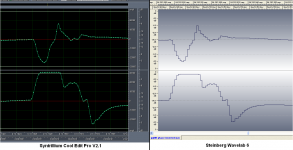 0 Cool Edit Pro V2.1vs Wavelab V6 screens.PNG52.3 KB · Views: 244
0 Cool Edit Pro V2.1vs Wavelab V6 screens.PNG52.3 KB · Views: 244 -
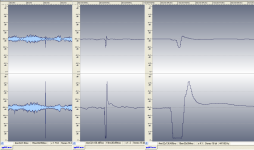 7 -0.5dB scratch Mahler S1.PNG51.7 KB · Views: 71
7 -0.5dB scratch Mahler S1.PNG51.7 KB · Views: 71 -
 6-0.26dB dirt Mahler S1.PNG50.7 KB · Views: 69
6-0.26dB dirt Mahler S1.PNG50.7 KB · Views: 69 -
 5 -3.37dB dirt Mahler S1.PNG63.9 KB · Views: 83
5 -3.37dB dirt Mahler S1.PNG63.9 KB · Views: 83 -
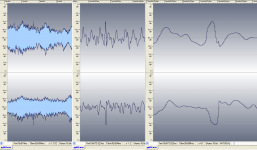 4 -5.28dB dirt Mahler S1.PNG61.9 KB · Views: 239
4 -5.28dB dirt Mahler S1.PNG61.9 KB · Views: 239 -
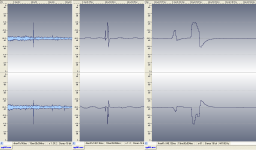 3 -5.71dB dirt Mahler S1.PNG50.8 KB · Views: 246
3 -5.71dB dirt Mahler S1.PNG50.8 KB · Views: 246 -
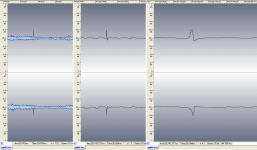 2 -11.75dB dirt Mahler S1.PNG44.7 KB · Views: 250
2 -11.75dB dirt Mahler S1.PNG44.7 KB · Views: 250 -
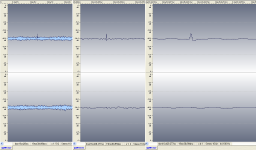 1-17.02dB scratch Mahler S1.PNG43 KB · Views: 245
1-17.02dB scratch Mahler S1.PNG43 KB · Views: 245
Me being argumentative? We have a new Mr.Pot!
Come on how many albums do you have that have not gone through a digital delay line during mastering? 5% maybe? For me if some DSP enhances the experience by removing extraneous ticks and pops that is a good thing. My opinion. Not an argument, just stating an opinion.
My wife and I enjoy concerts, Ballet and theatre. we go because we want to go together. You clearly have a less harmonious experience. Please however keep my wife out of the discussion.
Out of my classical collection it's at least 95% that are not digital. Pop is less, but I'd have to pick through to figure it out.
I used an example of a common scenario that includes a wife. But I didn't make it an insult. Does your wife know about your behaviour online?
But I didn't make it an insult. Does your wife know about your behaviour online?
Come on guys this is not necessary, My wife would not go to some of my musical "enjoyments" for anything, but when we do something together the "something" is only part of the equation.
Seeing digital click and pop removal (sugar cube) am little relieved that I am not thinking irrational. Internet says Digital delay for vinyl cutting was introduced in 70s, started in 80s and was common in 90s. One can never know what process were used in cutting albums. However point was if one has it one can always have a choice of using it or bypassing it. Occasionally use it or it may help in digitizing. After all in old days amplifier used to come with subsonic filter. Think of it as modern option with more control 🙂
Regards.
Regards.
Here is the patent 1980 https://www.google.com/patents/US4348754Come on how many albums do you have that have not gone through a digital delay line during mastering? 5% maybe?
About 5%? And not everyone used it either.
George,
I have repeated my measurements of clicks, for the reason I have much more suitable equipment for captures now. It was measured with Ortofon 2M red cartridge and with this phono preamplifier:
Discrete preamplifier for MM cartridge
I could not find any clipping, just big spikes all in amplifier linear range.
Attached are measurements, png images completely show all measurement settings, so I hope no additional explanations on sample rate etc. would be needed.
I have repeated my measurements of clicks, for the reason I have much more suitable equipment for captures now. It was measured with Ortofon 2M red cartridge and with this phono preamplifier:
Discrete preamplifier for MM cartridge
I could not find any clipping, just big spikes all in amplifier linear range.
Attached are measurements, png images completely show all measurement settings, so I hope no additional explanations on sample rate etc. would be needed.
Attachments
see attachment 1. You will see the analog-like representation from “Cool Edit” and the actual staircase form from “Wavelab”
George
Of course the staircase doesn't actually exist. It's just the representation on the screen. In reality only the samples are defined, and if you DA convert, it turns into a continuous wave.
This is important to mention because newbies look at this and say, see, I can actually hear the staircase. No. There is no staircase except on the screen.
Jan
Yes Jan, in majority cases when there is a reconstruction and LP filter in the DAC. If not, like in the old days of TDA, DAC output keeps the last analog output voltage before new sample comes and you can see the staircase on scope screen. It affects spectrum and amplitude response as well.
Attachments
Last edited:
- Status
- Not open for further replies.
- Home
- Member Areas
- The Lounge
- John Curl's Blowtorch preamplifier part II
